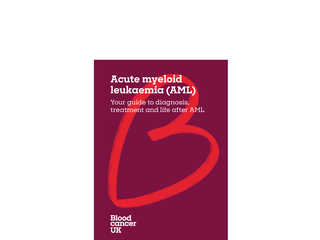Acute myeloid leukaemia (AML) symptoms and tests
Tests for acute myeloid leukaemia (AML)
You’ll have several tests to confirm whether you have AML or not. If you’re diagnosed with AML, you’ll have further tests to help plan the right treatment for you.
AML develops quickly, so if your doctor thinks you might have AML, they will normally do tests very quickly.
Things can happen very suddenly, and you might even start treatment within a day or two, to quickly get the leukaemia under control.
On this page:
Suspecting AML
Some people are told they might have AML after going to their GP with symptoms and having a blood test called a ‘full blood count’. If your blood results suggest that AML is a possibility, you might be phoned and told to come to hospital urgently. Most people need to start treatment very quickly, within a day or two.
Other people visit A&E as an emergency because they suddenly get very unwell and don’t know why. They’ll be checked in A&E and have tests, and they might be told in hospital or soon afterwards about the possibility of AML.
Confirming AML and planning treatment
A few key tests are used to confirm a diagnosis of AML, which we explain here:
Full blood count (FBC)
A full blood count measures the number of each type of cell in the blood – red blood cells, white blood cells and platelets. In AML, you can have too many of some blood cells, and not enough of others.
A sample of blood will be taken from a vein in your arm and sent to the lab for testing.
If you’re diagnosed with AML, you’ll have regular FBCs to monitor your condition. Find out more about blood counts in AML and what the results mean.
Blood film (blood smear)
A blood film means taking a sample of your blood to look at under a microscope. This allows the doctors to see if you have any leukaemia cells in your blood, and what they look like.
If doctors suspect AML, one of the first things they’ll want to check is whether you have a subtype of AML called APL, which has different treatments. APL cells look different to AML cells under the microscope. If you have APL, read our information about acute promyelocytic leukaemia (APL).
Bone marrow biopsy
AML begins in the bone marrow, so checking the bone marrow for leukaemia cells is an important test. This is one of the main tests used to confirm a diagnosis of AML.
Bone marrow is a soft, spongy tissue found in the centre of large bones. It is where the body makes its blood cells.
A bone marrow biopsy involves removing a sample of bone marrow from your hip bone. This can be looked at under a microscope.
AML is usually diagnosed if the number of myeloid blasts (immature blood cells) in your bone marrow is 20% or more.
We have more information about bone marrow biopsies.
Genetic tests (cytogenetic and molecular tests)
Tests can be done on a sample of your blood or bone marrow, to look for any changes (mutations) in the chromosomes or DNA in the abnormal cells. Sometimes these results can confirm a diagnosis of AML. They can also help your doctor plan the most effective treatment, as some mutations can be targeted by specific drugs.
These tests are sometimes called cytogenetic testing, karyotyping or FISH testing (all tests that look for changes in chromosome structure) and molecular genetics, PCR and sequencing tests (all tests that look for DNA sequence changes).
Find out more about genetic mutations and AML.
Immunophenotyping
Immunophenotyping is a test that looks at which proteins (markers) are on the surface of or inside the abnormal cells. This can help to tell doctors whether you have AML.

Order your free guide to AML
If you've been told you have AML, this booklet covers treatments, questions to ask your medical team, and real stories of people living with AML.
General health tests and infection screening
If you are diagnosed with AML, you’ll have a general health check. This will help work out your risk of side effects from treatment, and whether high-intensity or low-intensity treatment might be best.
You’ll have a range of tests to check your general health, including your heart, liver and kidney function, and tests for HIV and hepatitis B and hepatitis C. You’ll probably have a combination of blood tests and other tests such as a chest x-ray, ECG (electrical tracing of the heart) and echocardiogram (heart ultrasound).
Your healthcare team will talk to you about what the results of these tests mean for your treatment.
Tissue typing
Not everyone needs a stem cell transplant, but if your doctor thinks there is a chance you might need one in the future, they might talk to you about tissue typing. This means first doing tests to confirm your own tissue type, and then considering whether to start looking for a bone marrow donor whose tissue type closely matches yours. This might involve testing your siblings or looking for matches on bone marrow donor registries.
Even if you might not need a stem cell transplant, your doctor might talk to you about tissue typing, just in case you come to need a transplant later.
We explain more about stem cell transplants in the high-intensity treatment information.
We have more general information about other tests that are often used in blood cancer.

Having tests for blood cancer?
We're here to answer your questions or talk about how you're feeling. Contact our Support Service today.
